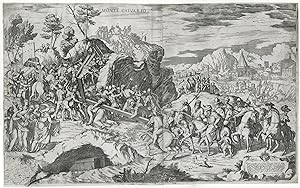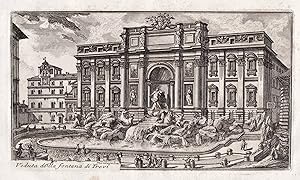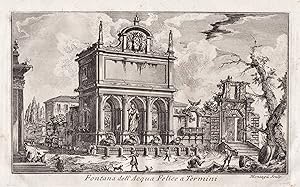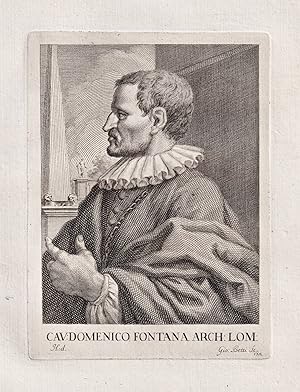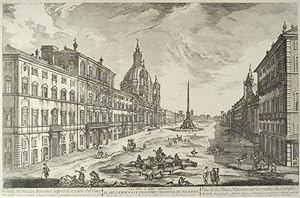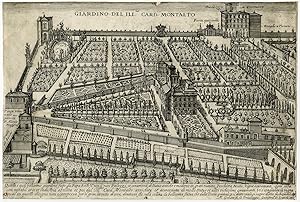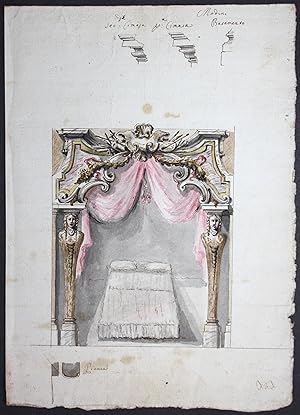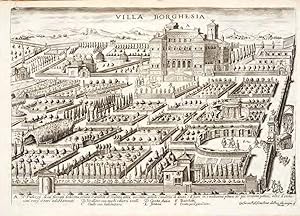Kunst, domenico fontana (10 Ergebnisse)
Produktart Auswahl aufheben
- Alle Produktarten
- Bücher (116)
- Magazine & Zeitschriften
- Comics
- Noten
- Kunst, Grafik & Poster (10)
- Fotografien (4)
- Karten (3)
-
Manuskripte &
Papierantiquitäten (5)
Zustand
- Alle
- Neu
- Antiquarisch/Gebraucht
Einband
Weitere Eigenschaften
- Erstausgabe
- Signiert (1)
- Schutzumschlag
- Angebotsfoto (9)
Land des Verkäufers
Verkäuferbewertung
-
Architekt, Maler, Bildhauer. Entdeckte 1592 erste Marmortafeln, Inschriften etc. bei Kanalbauarbeiten in Pompeji. 1543 Melide - 1607 Neapel. Brustbild im Oval, davor Putto mit Schriftband, links im Hintergrund Obelisk. Radierung von Schellenberg. 127 x 85 mm. schönes Exemplar mit Rand.
-
Rare-Antique Master Print-CALVARY MOUNTAIN-JESUS BEARING CROSS-Fontana-Campagnola-1584
Erscheinungsdatum: 1584
Anbieter: Pictura Prints, Art & Books, Overasselt, Niederlande
Kunst / Grafik / Poster
No binding. Domenico (illustrator). 'MONTE CALVARIO'Large engraving printed from two plates depicting Jesus bearing the Cross up Mount Calvary and falling. The different stages of Christ's procession to Calvary. He falls in the center under the weight of the cross. At left Saint Veronica who approaches Christ to wipe his face, leads a group of women including the Virgin. Above preparations are underway to raise the crosses. Very rare!Made by Giovanni Battista Fontana after Domenico.Engraving on hand laid (verge) paper. Watermark: French Lily in circle (Italian paper).Sheet size: 66.5 x 41.6 cm (26.18 x 16.38 inch). Image size: 65.5 x 39.8 cm. (25.79 x 15.67 inch).CALVARY MOUNTAIN-JESUS BEARING CROSS-MONTE CALVARIOPCO-EXPO-LARGEThe print is dedicated to the Prior of the church of the Trinita in Venice, Pierto Lippomani. Originally published ca. 1560-1573 by Domenico Zenoi (Italian, active Venice and Padua, 1559-74), and in 1584 in Rome, by Giovanni Battista di Lazzaro Panzera da Parma (Italian, born 1541, active Rome 1577-98).Reference: Bartsch XVI.220.13.II. Condition: good, given age. Paper loss in left bottom remargined and retouched with pencil. Tear at top middle restored. Currently attached to modern paper for strength and handling. General age-related toning and/or occasional minor defects from handling. Please study scan carefully.
-
Veduta della Fontana di Trevi" - Roma Rom Rome / Fontana di Trevi Trevi-Brunnen
Verlag: Rom ca. 1760., 1760
Anbieter: Antiquariat Steffen Völkel GmbH, Seubersdorf, Deutschland
Kunst / Grafik / Poster
Original Kupferstich von ca. 1760. -- Blatt-Maße: ca. 20 x 30 cm. -- im Außenrand leicht fleckig, sonst gut erhalten. || Original copper engraving from c.1760. -- slightly stained on the outer margin, otherwise in good condition. || Incisione originale su rame del 1760 circa. Sprache: Italienisch Gewicht in Gramm: 10.
-
Fontana dell'Acqua Felice a Termini" - Roma Rom Rome / Mosesbrunnen Fontana dell Acqua Felice Fontana del Mosè
Verlag: Rom ca. 1760., 1760
Anbieter: Antiquariat Steffen Völkel GmbH, Seubersdorf, Deutschland
Kunst / Grafik / Poster
Original Kupferstich von ca. 1760. -- Blatt-Maße: ca. 20 x 30 cm. -- im Außenrand leicht fleckig, sonst gut erhalten. || Original copper engraving from c.1760. -- slightly stained on the outer margin, otherwise in good condition. || Incisione originale su rame del 1760 circa. Sprache: Italienisch Gewicht in Gramm: 10.
-
Cav. Domenico Fontana Arch.Lom" - Domenico Fontana (1543-1607) Italian painter sculptor Mannerism Portrait
Verlag: Firenze c. 1770., 1770
Anbieter: Antiquariat Steffen Völkel GmbH, Seubersdorf, Deutschland
Kunst / Grafik / Poster
Kupferstich-Portrait von ca. 1770. -- Blatt-Maße: ca. 29,5 x 20 cm; Portrait-Maße: ca. 17 x 12 cm. - gut erhalten. || Copper engraved portrait from around 1770. -- in very good condition. Sprache: Italienisch Gewicht in Gramm: 10.
-
ROM. "Veduta di Piazza Navona sopra le rovine del Circo Agonale". Schöner Blick auf die belebte Piazza Navona und den Vierströmebrunnen (Fontana dei Quattro Fiumi), links die Kirche Sant' Agnes in Agone.
Anbieter: Peter Bierl Buch- & Kunstantiquariat Inh.: Andrea Bierl, Eurasburg, Deutschland
Kunst / Grafik / Poster
Kupferstich von Domenico Montaigu nach Jean Barbault, um 1750, 34,5 x 56 cm. Die prächtige Ansicht im Stil von Giovannia Battista Piranesi (1720-1778). - Gerahmt.
-
Rare Antique Master Print-VILLA-CARDINAL MONTALTO-SIXTUS V-Greuter-ca. 1630
Anbieter: ThePrintsCollector, Zeeland, Niederlande
Kunst / Grafik / Poster
Antique Master Print, titled: 'Giardino del ill.mo card. Montalto.' - Rare antique master print. View of the palace and gardens of Cardinal Montalto in Rome. Pope Sixtus V or Xystus V (1521-1590), born Felice Peretti di Montalto, was Bishop of Rome from 24 April 1585 to his death in 1590. He is known as Cardinal Montalto. During the pontificate of his political enemy Gregory XIII (1572 85), Cardinal Montalto lived in enforced retirement, occupied with the care of his property, the Villa Montalto, erected by Domenico Fontana close to his beloved church on the Esquiline Hill, overlooking the Baths of Diocletian. The first phase (1576 80) was enlarged after Peretti became pope and was able to clear buildings to open four new streets in 1585 6. The villa contained two residences, the Palazzo Sistino or "di Termini" ("of the Baths") and the casino, called the Palazzetto Montalto e Felice. Engraving on laid paper. Watermark: Circle with an anchor. Description: Very rare. From a series of at least 8 views of gardens in Rome. State: Only state. Ref: Hollstein 73.Artists and Engravers: Made by 'Mattthaeus Greuter' after 'Matthaeus Greutter'. Matthaeus Greuter (active first half of the 17th. Century) originated from Strasbourg. He worked in Rome and Venice. Condition: Fair, given age. Margins cropped to the image edge. Pinholes in the corners and margin edges, with rust remains. Small paper loss in the top margin and right bottom corner, backed. Small worm hole at top left. General age-related toning and/or occasional minor defects from handling. Please study scan carefully. Storage location: R1-037 LATPC LATPC The overall size is ca. 13.9 x 9.3 inch. The image size is ca. 13.9 x 9.3 inch. The overall size is ca. 35.2 x 23.7 cm. The image size is ca. 35.2 x 23.7 cm.
-
Design for a baldachin.
Verlag: Rome c. 1720., 1720
Anbieter: Antiquariat Steffen Völkel GmbH, Seubersdorf, Deutschland
Kunst / Grafik / Poster Signiert
Sheet: 284 x 207 mm; pen, brown ink and watercolor; verso ascribed to Vasconi in a contemporary German hand: Ein Camin von H. Vasconi inventirt u. (beschert?)." Signed in lower right: F.V.F. (Filippo Vasconi fecit) Filippo Vasconi was an Italian architect and engraver. He was a nephew of Carlo Fontana (1638-1714). His father was agent of Grand Duke Cosimo III de 'Medici, while his mother was the daughter of Carlo Fontana and sister of Francesco Fontana (1668-1708). In 1706, he met the architect and set designer Filippo Juvarra (1678-1736), both combined a longlife friendship. Vasconi, Domenico Gregorini (1692-1777), Pietro Passalacqua (1690-1748, nephew of Juvarra) and the painter Placido Romoli (1690-1750) formed a group of artists sponsored by Cardinal Ottoboni and admitted to the prestigious Pontifical Academy of the Virtuosi al Pantheon. Vasconi is mostly known for his architectural engravings as well as his engravings after drawings and paintings by other artists. In later years his activity specialized more and more towards the representation of machines and other equipment used in parties and celebrations, and the depiction of festivals. Besides the two designs in our inventory, we were able to locate only one other drawing which can be attributed without doubt to Vasconi. It is the first draft in an album by Filippo Juvarra, today in the Metropolitan Museum of Art. The present drawing is most likely the only known signed drawing by Filippo Vasconi. - Very rare. Bibliography: B. Contardi and G. Curcio - In urbe architectus: modelli, disegni, misure, la professione dell'architetto, Roma 1680-1750, Rome, 1991; G. Cantone, L. Marcucci, E. Manzo - Architettura nella storia. Scritti in onore di Alfonso Gambardella. Milano, 2007; H. A. Millon - Key Monuments of the History of Architecture. Englewood Cliffs, 1964. Sprache: Italienisch Gewicht in Gramm: 550.
-
Suite of 8 engraved plates depicting the most notable gardens of contemporary 17th century Rome.
Verlag: Rome, sold by Giovanni Giacomo Rossi (1666 to 1670)., 1670
Anbieter: Hünersdorff Rare Books ABA ILAB, London, Vereinigtes Königreich
Kunst / Grafik / Poster
Soft cover. Zustand: Very Good. [Rossi, Giovanni Giacomo (publisher) Roman Baroque Gardens. Rome c1670]. Folio. 8 engraved plates with title and descriptive key in roman and italic letter. Size of each 260 x 380mm. Bound in contemporary limp vellum with decorative blind-stamp on front and back cover, early ink library shelf. A portfolio of garden designs individually selected from the Rome print seller, Giovanni Rossi, and privately bound. Collections of such prints were acquired by travellers in Italy from about 1600, either as reminders of a visit, or as is most likely in the present case, for use as a pattern book of ideas in laying out grounds. The gardens represented here are as follows: I. Villa Pamphili, built from 1644, for the Pamphili family by Alessandro Algardi, the site (on the ancient Via Aurelia) offered a magnificent vista of Rome and a particularly spectacular view of St Peter s . The aspect shown here focuses on the view of the villa as seen from the hippodrome, and theatre with statuary and fountains. II. Villa Borghesia, begun in 1609, was built near the Porta Pinciana originally by the architect Flaminio Ponzio. The gardener in charge was listed as Domenico Savino who came from Montepulciano. The present view would appear to be that corresponding to the description of the 'first garden area . densely planted with evergreen trees and divided . into twenty-three roughly rectangular compartments outlined by espaliers of juniper, laurel, royal laurel, and mezereon (an early-flowering medicinal variety of laurel). Noblemen are seen entering the main gate into the 'semicircular piazza outlined by espaliered laurel trees to form a wall of niches in which were set alternately peperino benches and antique statues ( peperino : dark volcanic rock containing crystals) . Visible at the entrance are the famous herm statues by Pietro Bernini of the horticultural deities, Priapus and Flora . Herms and statues also adorn each compartment, and an amusing variety of topiaried trees runs along the boundary wall to the left of the entrance. The key below draws attention to the aviaries near the villa, a circular antique grotto resembling the nymphaeum of the Villa Adriana, and the gardener s house. Tunnels of firs are referred to as Boschetti ; hidden among these is the wine grotto or tinello , a domed oval arcade . set about 3 meters underground . III. Montalto. The largest estate within the city walls at the time; the several buildings derived ultimately from rustic farm buildings were conceived by Domenico Fontana and begun around 1578. The present magnificent engraving, signed by M. Greuter, would appear to date from about 1620. Still evident is the wedge-shaped design of compartments in front of the villa corresponding to one of the earliest pieces of land bought by Cardinal Montalto s family. The many rectilinear plots contained in the remaining walled area are characterized by delightful central fountains each within a different geometric-shaped pool. Behind the house is a semicircular piazza lined with huge triumphal urns; along the front allées are statues of exotic beasts; these lead to the Stalle de Lioni (lion pens). In the north-west corner can been the oval fishpool dominated by Bernini s sculpted group Neptune and a Triton calming the waves (this is now in the Victoria & Albert Museum). IV. Villa Medici, purchased and revised by Cardinal Ferdinand de Medici from circa 1576. The Florentine architect, Bartolomeo Ammanati, undertook the plan, and the villa was erected on the Monte Pincio overlooking Rome. More compact than those outside the city, it nevertheless had space for many fine statues and fountains (named here in the key). Its spectacular feature was the water stair descending from a mausoleum built on a steep slope to the right of the villa on which groves of cypresses were planted; below was a galleried grotto. An Egyptian obelisk with hieroglyphs stands out among the bordered compartments.
-
COLECÇÃO DE 20 GRAVURAS DA VIDA DE PIO VI - ROMA. 1803-1805.
Anbieter: Livraria Castro e Silva, Lisboa, Portugal
Kunst / Grafik / Poster
Hard Cover. Zustand: Good. Formato oblongo. Com 20 fólios de 49x60 cm (dimensão gráfica de 32x45 cm) com gravuras abertas em chapa de metal. Encadernação meia-amadora com uma generosa lombada e cantos em pele (cansados) e com vestígios de manchas de humidade. Exemplar apresenta as gravuras com sinais de manuseamento e leves manchas de humidade. Colecção bio iconográfica da atribulada vida do Papa Pio VI, representando os seus momentos mais importantes, nomeadamente: a Obediência da Curia Romana; as recepções aos grandes monarcas da Europa; o acordo com Napoleão; a sua prisão pelas tropas francesas; a fuga pelos Alpes; a sua morte; o seu funeral, entre outros. Obra da autoria de cinco desenhadores, dos quais se destacam Luigi Agrícola (autor de oito gravuras) e G. Reys (autor de nove gravuras), tendo ainda a participação de Ercole Petrone, Fran. Cecchi e L. Scotti (cada um autor de uma gravura). Relativamente à gravação, ou abertura das chapas, esta operação teve a participação de muitos abridores dos quais se destacam os seguintes três: Pietro Bonato e G. Petrini, cada um com 4 gravuras, e Alesandro Mocchetti com 3 gravuras. Os restantes gravadores abriram apenas uma chapa cada um, nomeadamente: Nic. Aureli, Gio. Balestra, Pietro Fontana, Domenico Marchetti, Girolamo Carattoni, Pietro Savorelli, Ant. Ricciani, Ang. Campanela e Gio Batta Leonetti. Todas as gravuras estão numeradas (gravados nas chapas no canto inferior direito) e têm legenda com o título, autoria dos desenhadores e dos gravadores e data de edição. Luigi Agricola (1750-1821?) foi um pintor italiano sediado em Roma. Dedicava-se também à joalharia. Pintou São Miguel Arcanjo para a Academia de São Lucas em Roma, onde era professor. Pintou também um retábulo de Santa Isabel, Rainha de Portugal, para a Igreja de Santo António dos Portugueses em Roma. O Papa Pio VI (1717-1799) - nascido Conde Braschi - foi Papa de 1775 até à sua morte. Aos 17 anos era já advogado e aos 38 era ordenado sacerdote. A paz dos anos iniciais do seu pontificado permitiu-lhe realizar obras de utilidade e de grande alcance social e cultural. Porém, em 1796, as tropas da República Francesa, sob o comando de Napoleão Bonaparte, invadiram a Itália e derrotaram o exército papal. Pio VI pediu a paz que foi assinada em 1797, mas em 28 de Dezembro do mesmo ano, num motim realizado pelas forças papais contra alguns revolucionários italianos e franceses, criou-se um novo pretexto para uma nova invasão francesa. Berthier marchou para Roma sem oposição e em 10 de Fevereiro de 1798 proclamou a República Romana, exigindo do Papa a renúncia de seus poderes temporais. Pio VI recusou e foi feito prisioneiro, tendo sido escoltado do Vaticano para Siena e depois para Florença. O Papa num longo percurso pelos Alpes ? retratado nesta obra - dirigiu-se para o exílio, passando por Parma, Piacenza, Turim e Grenoble até à cidadela de Valence-sur-Rhône, onde faleceu em 29 de Agosto de 1799, com 81 anos de idade e 24 de pontificado, o mais longo até então. COLLECTION OF 20 ENGRAVINGS DEPICTING THE LIFE OF POPE PIO VI - ROMA. 1803-1805. Dim.: Oblong with 20 folios measuring 49x60 cm (graphic dimensions 32x45 cm) with steel engravings. Binding: amateur binding with large leather spine and (worn) corners. Shows light moisture stains. Copy showing handling and slight foxing on engravings. Bio-iconographic collection of the troubled life of Pope Pio VI, namely the Obedience to the Roman Curia; the reception of important European monarchs; the agreement with Napoleon; his arrest by the French troops; his death; his funeral, among others. This work was made by five designers: Luigi Agrícola (author of eight engravings); G. Reys (author of nine engravings); Ercole Petrone, Fran. Cecchi and L. Scotti (one engraving each). As for the plate engraving, this was made by several engravers: Pietro Bonato and G. Petrini, each with four engravings; Alesandro Mocchetti with three; and with one engraving each Nic. Aureli; Gio. Balestra; Pietro Fontana; Domenico Marchetti; Girolamo Carattoni; Pietro Savorelli; Ant. Ricciani; Ang. Campanela; and Gio Batta Leonetti. All the engravings are numbered (engraved at the right bottom corner) and have captions with title, name of the designer and engraver, as wellas date of edition. Luigi Agricola (1750 ? 1821 or after) was an Italian painter active in Rome. He also worked with jewellery. He painted St. Michael the Archangel for the Academy of St Luke in Rome, where he was a teacher. He painted an altarpiece of St Elizabeth, Queen of Portugal for the church of Sant"Antonio dei Portoghesi, Roma. Pope Pio VI (1717-1799) ? born Count Braschi ? was Pope from 1775 until his death. At 17 years old was already a lawyer and at 38 was ordained priest. The peace lived during his first 10 years as Pope allowed him to carry out importante social and cultural works. However, in 1796, the French troops lead by Napoleon invaded Italy and defeated the Pope?s army. Pio VI signed the peace in 1797 but on the 28th December of that same year, a riot of Italian and French revolutionaries lead to another French invasion. Berthier marched to Rome with no opposition and on February 10th 1798 he proclaimed the Roman Republic, demanding that the Pope renounced his temporal power. Pio VI refused and was arrested and taken from the Vatican to Siena and then to Florence. He died in August 29th 1799 in exile in Valence-sur-Rhône. He was 81 years old and had 24 of pontificate, the longest until then. Relação das gravuras/List of engravings: Nº 1. Solemme Coronazione del Sommo Pontefice Pio Sesto [.] il di Febbrajo 1775. Luigi Agricola Inv. e dis. || Pietro Bonato inc. Roma. Anno 1805. Nº 2. Accoglimento di S. S. Pio VI alle LLAR il Granduca e Granduchessa gia regnanti delle Russie. [.] il di Febbrajo 1782. Luigi Agricola Inv. e dis. || Nic. Aureli inc. Roma. Anno 1805. Nº 3. Abboccamento del Som. Pont. Pio VI. con S. M. I. & R. Giuseppe II. [.] il di 24 Marzo 1782. Luigi Agricola Inv. e dis. || G. Petrini inc. Roma.



